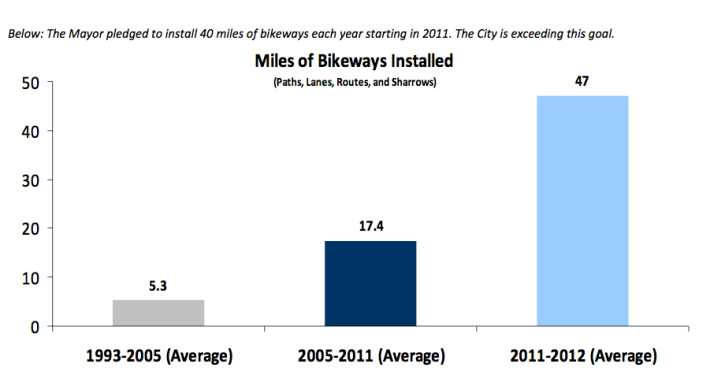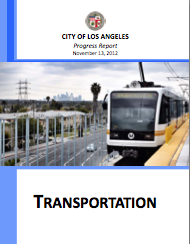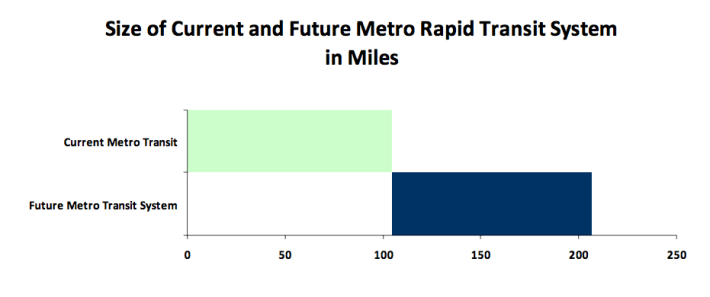Last month, the Mayor's Office released a report ranking itself on how it achieved, or didn't achieve, its stated transportation goals over the last seven and a half years. Rather than traditional grades, the report gave the offices green (for "completed"), yellow (for "in the works") or red (for "didn't/won't happen) on a variety of transportation issues.
As speculation on whether the "Subway Mayor" is going to move on to Washington, D.C. to be the next Secretary of Transportation intensifies, this report could be a resume of sorts for the Mayor. If the rumored appointment does happen, a report released to the yawn of the local press corps could become fodder for national debate. While the report does have many more green dots than yellow or red, after all what politician releases a report that shows staff underperforming, there is enough red and yellow to give the report an honest look. And after all, transportation is one of the areas where Villaraigosa and his team excel.
To nobody's surprise, the Mayor's Office gives itself high marks on transit expansion, noting the passage of Measure R in 2008 and the less-exciting but perhaps just-as-important Proposition B in 2006. Both the County and State transportation taxes have allowed Metro to make major investments in transit expansion projects.
In addition to the tax passages, the report lists a handful of projects completed in recent years: The Gold Line Eastside Extension, the first Phase of the Expo Line, the Orange Line Chatsworth Extension, and even the opening of the original Orange Line. During his campaigns, Villaraigosa ran on doubling the rapid transit and rail system. As the chart below shows, Los Angeles County is well on the way to reaching that goal thanks in large part to Villaraigosa's leadership.
While Villaraigosa has talked about the importance of maintaing low fares and having an expanded bus network, neither issue is mentioned in the report. As the Bus Riders Union and their allies have noted, despite the transit taxes, bus ridership has shrunk during the Mayor's term, even if the trend seems to have reversed itself in the last two years.
Another area where the Mayor did not meet a goal was the rejection of Measure J earlier this year. While votes are still being counted and the percentage of votes in favor of extending the 2008 Measure R sales tax until 2069 continues to grow; it is wildly unlikely to cross the two-thirds thresh hold necessary. Getting the Measure on the ballot was a difficult enough feet, but it looks as though the vote will fall just short. It currently is receiving the support of 65.88% of votes counted. It needs 66.7%
Another area where the Mayor's Office gave itself good marks was with the city's success lobbying for federal transportation dollars. The report notes the success the city enjoyed lobbying for $130 million of American Reinvestment and Recovery Act Funds (aka 2009 Stimulus Funds) and the mixed success of the America Fast Forward nee 30/10 Plan. America Fast Forward was a plan put forward by the Mayor's Office and Move L.A. that would encouraged a change in the federal funding formulas to benefit areas that are taxing themselves to pay for new projects. "We're not asking for a gift, we're asking for a loan," was a popular phrase used to explain the plan.
The program was a partial success. While many of the asks in America Fast Forward occured, there has not been a rush of federal dollars to Los Angeles to speed up construction of new projects. The Westside Subway and Regional Connector have received some federal transit dollars and the Crenshaw Line received a large $534 million no-interest loan, but overall Los Angeles will not see "30 years of transit projects built in 10 years."
Which is not to say the campaign was a failure. The America Fast Forward Campaign did help change federal policy in the 2012 Federal Transportation Bill. In short, the MAP 21 included the following changes:
- Expands funding for TIFIA to $750 million in FY 2013 and $1 billion in FY 2014.
- Increases the share of project costs that TIFIA can cover from 33 percent to 49 percent
- Enables US DOT to make loans to a group of related projects
- Authorizes US DOT to make upfront conditional commitments to projects through Master Credit Agreements making TIFIA assistance more predictable for larger, multi‐year phased capital programs.
- Authorizes US DOT to allow limited interest rate buydowns.
- Provides $105 billion (roughly $54 billion per year) for the nation’s surface transportation programs.









